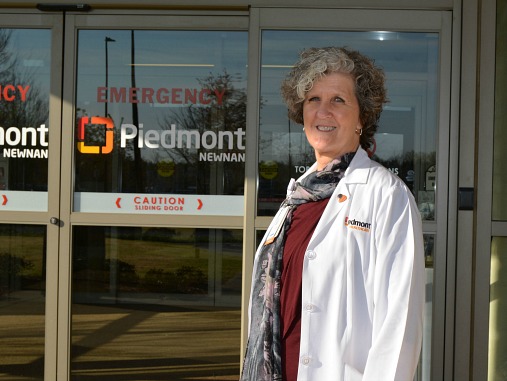Piedmont Newnan Hospital has been designated as only the third Remote Treatment Stroke Center in Georgia and the first in EMS Region 4 by the Georgia Department of Public Health’s Office of EMS and Trauma.
The designation recognizes Piedmont Newnan’s high-quality care of stroke patients while providing state-of-the-art diagnostics and emergency treatment.
“This designation is a huge win for our Coweta County community,” said Mike Robertson, CEO of Piedmont Newnan Hospital. “We know time is of the essence when it comes to stroke diagnosis and treatment. Ambulances carrying patients who are exhibiting stroke-like symptoms will now come to Piedmont Newnan for treatment versus traveling to a facility outside of the county.”
Stroke is the fifth leading cause of death and No. 1 cause of disability in the United States. Georgia is in the stroke belt, an 11-state region where studies show that the risk of stroke is 34 percent higher for the general population than in other areas of the country.
The Georgia Department of Health “commends you and your staff for the commitment to excellence in stroke care that is being provided at your facility,” J. Patrick O’Neal, M.D., the Department of Public Health’s Director of Health Protection, wrote in a letter sent to the hospital. “Reducing the incidence and the impact of strokes on individuals in Georgia is exceedingly important, and is in keeping with Public Health’s desire to protect and improve the health and lives of individuals throughout our state.”
O’Neal continued with his praise and wrote “The Department applauds Piedmont Newnan Hospital for this achievement and appreciates the contribution that you make to the health and well-being of Georgians, as well as to those visiting our state.”
The process to become a Remote Treatment Stroke Center is intricate and demanding. In August 2014, Piedmont Newnan hired Stroke Program Manager Deborah Camp to lead the hospital’s efforts to achieve the designation. Camp served as chair of the Georgia Stroke Professional Alliance and is an Advanced Stroke Life Support (ASLS) Instructor.
“It has been a long process but I’m so proud of our hospital caregivers and partners in EMS for their hard work and their commitment to bringing outstanding stroke care to our community,” Camp said. “This involved an intense training process and collaboration with our Emergency Department, board-certified neurologists, ICU, radiology, lab, and just about every other department to support a door-to-needle time of less than 60 minutes.”
The door-to-needle time refers to the timely administration of the clot-busting drug tPA or tissue plasminogen activator. It is used to treat acute ischemic stroke and must be given within three to four-and-a-half hours of the onset of symptoms.
“Approximately 2 million brain cells die each minute when you are having a stroke so getting to the closest stroke-ready hospital is key in preventing disability,” Camp said. “Unlike other parts of the body, the brain cannot repair itself so the damage that occurs during a stroke is permanent.”
Camp said members of the community should know the FAST acronym so they can recognize signs of a stroke and get help as quickly as possible.
- Face drooping – Does one side of the face droop or is it numb? Ask the person to smile. Is the person’s smile uneven?
- Arm weakness – Is one arm weak or numb? Ask the person to raise both arms. Does one arm drift downward?
- Speech difficulty – Is speech slurred? Is the person unable to speak or hard to understand? Ask the person to repeat a simple sentence, like “The sky is blue.” Is the sentence repeated correctly?
- Time to call 9-1-1 – If someone shows any of these symptoms, even if the symptoms go away, call 9-1-1 and get the person to the hospital immediately. Check the time so you’ll know when the first symptoms appeared.






